|
Lalibella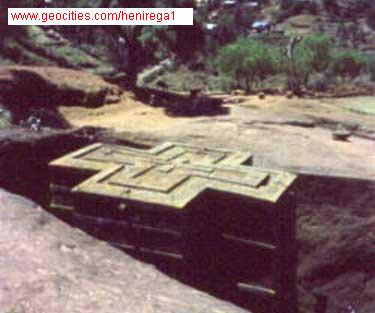 ("lah-lee-BELL-uh") Known as the Eight Wonder of the World, Lalibela has an intriguing and mysterious past filled with legend. The small, rustic city of Lalibella, overshadowed by the great Mount Abune Yosef, seems unremarkable upon arrival. However when the tourist comes upon the city•s churches, it is as though he•s been transported back in time: priests walk around in medieval robes, the chanting of monks echoes in the hills and the city•s main attraction, the rock-hewn churches, are absolutely breathtaking. Even the most jaded of tourists is bewildered by these wonders of architecture, in which enormous, still functioning monolithic churches dating back to the 1200s have been fashioned out of the solid rock itself. The insides of the churches, which were supposedly built by angels, are also incredible, decorated with detailed frescoes and elaborate carvings. The largest of the rock-hewn churches is Bet Medhane Alem, which most tourists visit first. The most famous of the churches, with whose image the city of Lalibella is most often associated, is known as Bet Giorgis, carved into the shape of a giant cross. When traveling in Ethiopia, a trip to the historically amazing Lalibella is definitely not to be missed. ("lah-lee-BELL-uh") Known as the Eight Wonder of the World, Lalibela has an intriguing and mysterious past filled with legend. The small, rustic city of Lalibella, overshadowed by the great Mount Abune Yosef, seems unremarkable upon arrival. However when the tourist comes upon the city•s churches, it is as though he•s been transported back in time: priests walk around in medieval robes, the chanting of monks echoes in the hills and the city•s main attraction, the rock-hewn churches, are absolutely breathtaking. Even the most jaded of tourists is bewildered by these wonders of architecture, in which enormous, still functioning monolithic churches dating back to the 1200s have been fashioned out of the solid rock itself. The insides of the churches, which were supposedly built by angels, are also incredible, decorated with detailed frescoes and elaborate carvings. The largest of the rock-hewn churches is Bet Medhane Alem, which most tourists visit first. The most famous of the churches, with whose image the city of Lalibella is most often associated, is known as Bet Giorgis, carved into the shape of a giant cross. When traveling in Ethiopia, a trip to the historically amazing Lalibella is definitely not to be missed. Axum Tsion 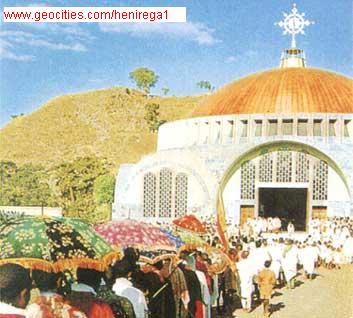 ("MAH-riam TSEE-on") Also known as the Church of Saint Mary of Zion, this is Axum's most famous church, whose grounds hosts two separate houses of worship: the modern-looking domed church, built in the 1960s, and the smaller, much older compound within its walls; here tourists can hope to catch a glimpse of the lost Ark of the Covenant, where it is heavily guarded by the holy Guardian of the Ark--according to legend, this church is the supposed final resting place of the famed Biblical item. ("MAH-riam TSEE-on") Also known as the Church of Saint Mary of Zion, this is Axum's most famous church, whose grounds hosts two separate houses of worship: the modern-looking domed church, built in the 1960s, and the smaller, much older compound within its walls; here tourists can hope to catch a glimpse of the lost Ark of the Covenant, where it is heavily guarded by the holy Guardian of the Ark--according to legend, this church is the supposed final resting place of the famed Biblical item. Lucy-Australopithecus afarensis 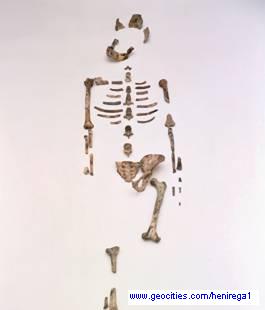 . afarensis, a gracile australopith that thrived in eastern Africa between about 3.9 million and 3 million years ago. The most celebrated fossil of this species, known as Lucy (Amharic Dinkinesh), is a partial skeleton of a female discovered by American paleoanthropologist Donald Johanson in 1974 at Hadar, Ethiopia. Lucy lived 3.2 million years ago. Scientists have identified several hundred fossils of A. afarensis from Hadar, including a collection representing at least 13 individuals of both sexes and various ages. . afarensis, a gracile australopith that thrived in eastern Africa between about 3.9 million and 3 million years ago. The most celebrated fossil of this species, known as Lucy (Amharic Dinkinesh), is a partial skeleton of a female discovered by American paleoanthropologist Donald Johanson in 1974 at Hadar, Ethiopia. Lucy lived 3.2 million years ago. Scientists have identified several hundred fossils of A. afarensis from Hadar, including a collection representing at least 13 individuals of both sexes and various ages. Ras Dashen 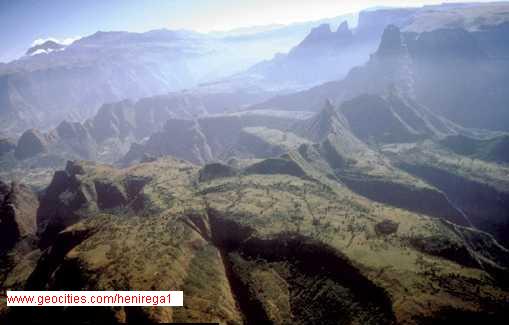 , mountain in northern Ethiopia, the highest peak in Ethiopia and fourth highest in Africa. Towering over the Ethiopian Plateau at 4,620 m (15,158 ft) above sea level, Ras Dashen is part of the 'Semean' Mountains, a volcanic range of jagged peaks. Adjacent to the mountain is the 179-sq km (69-sq mi) 'Semean Mountains National Park', which was designated a World Heritage Site in 1978 by the United Nations Educational, Scientific and Cultural Organization (UNESCO). UNESCO's World Heritage list recognizes the world's unique natural and cultural places. Three animals unique to Ethiopia are found in the area: the Walia ibex, the Semean jackal, and the gelada baboon. The mountain is also the home of the lammergeyer, a vulture with a 2.4-m (8-ft) wingspan, known as the "bone-breaker" for its habit of breaking its prey's bones by dropping them on rocks. , mountain in northern Ethiopia, the highest peak in Ethiopia and fourth highest in Africa. Towering over the Ethiopian Plateau at 4,620 m (15,158 ft) above sea level, Ras Dashen is part of the 'Semean' Mountains, a volcanic range of jagged peaks. Adjacent to the mountain is the 179-sq km (69-sq mi) 'Semean Mountains National Park', which was designated a World Heritage Site in 1978 by the United Nations Educational, Scientific and Cultural Organization (UNESCO). UNESCO's World Heritage list recognizes the world's unique natural and cultural places. Three animals unique to Ethiopia are found in the area: the Walia ibex, the Semean jackal, and the gelada baboon. The mountain is also the home of the lammergeyer, a vulture with a 2.4-m (8-ft) wingspan, known as the "bone-breaker" for its habit of breaking its prey's bones by dropping them on rocks. Axum ("AHK-soom") 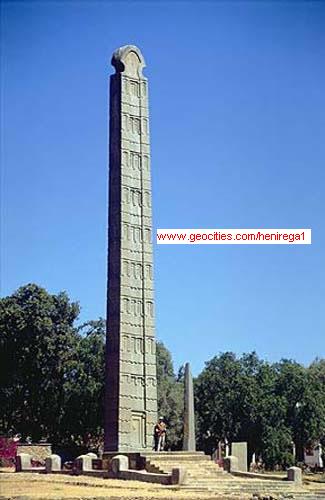 , A visit to the Queen of Sheba’s Palace, known as Taakha Maryam in the local language, is a delightful experience; you can also observe the astounding work of architecture that is the Queen of Sheba’s Bath. All of these sites are to be found in Axum. Axum served as the capital city of Ethiopia’s famous Queen of Sheba. During the first century AD, Axum was recognized as hugely powerful state, akin in strength and civilization to the great cities of the Roman Empire, and known as a center of trade and culture. Axum served as the capital of the far-reaching Axumite kingdom that flourished for over a thousand years. During its reign, the Axumite civilization is credited with having established the ancient Ethiopian language Ge’ez as well as introducing the concept of organized religion, in the form of Christianity, to the country. , A visit to the Queen of Sheba’s Palace, known as Taakha Maryam in the local language, is a delightful experience; you can also observe the astounding work of architecture that is the Queen of Sheba’s Bath. All of these sites are to be found in Axum. Axum served as the capital city of Ethiopia’s famous Queen of Sheba. During the first century AD, Axum was recognized as hugely powerful state, akin in strength and civilization to the great cities of the Roman Empire, and known as a center of trade and culture. Axum served as the capital of the far-reaching Axumite kingdom that flourished for over a thousand years. During its reign, the Axumite civilization is credited with having established the ancient Ethiopian language Ge’ez as well as introducing the concept of organized religion, in the form of Christianity, to the country. Blue Nile (amharic Abay), 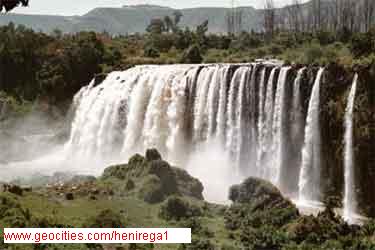 ,these falls are also known as Tis Isat in Amharic, meaning •smoke of fire,• a title that refers to the fine, smoke-like spray that rises from the falling waters and mists the land for miles around. Found in Bahir Dar, these are the second largest falls on the African continent, and are an incredible sight to see, particularly during the rainy season when the fall volumes exceed 8,000 cubic meters of water falling per second. ,these falls are also known as Tis Isat in Amharic, meaning •smoke of fire,• a title that refers to the fine, smoke-like spray that rises from the falling waters and mists the land for miles around. Found in Bahir Dar, these are the second largest falls on the African continent, and are an incredible sight to see, particularly during the rainy season when the fall volumes exceed 8,000 cubic meters of water falling per second. Gondar ("GON-der"), 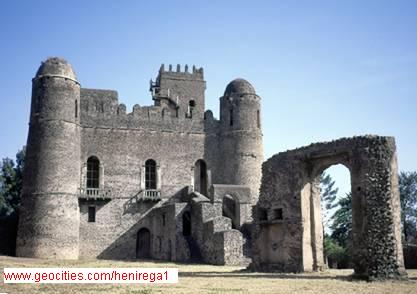 ,Once Emperor Fasilidas• capital city during the fifteenth century, today Gondar offers the traveler the chance to return to the grandeur and imperial aura of the days of its reign. Gondar boasts many medieval castles, carved of brown basalt stones and held together by mortar, that are comparable in pomp and stature to those found in parts of Europe and India. While some of Gondar•s monuments have been damaged by the passage by time and by a war bombing during 1941, most of them have remained unchanged and truly impressive. ,Once Emperor Fasilidas• capital city during the fifteenth century, today Gondar offers the traveler the chance to return to the grandeur and imperial aura of the days of its reign. Gondar boasts many medieval castles, carved of brown basalt stones and held together by mortar, that are comparable in pomp and stature to those found in parts of Europe and India. While some of Gondar•s monuments have been damaged by the passage by time and by a war bombing during 1941, most of them have remained unchanged and truly impressive. |